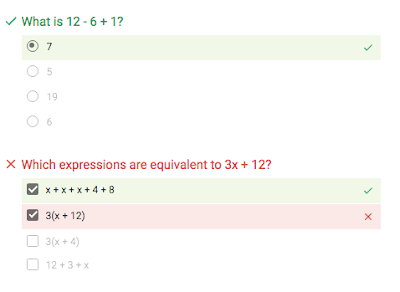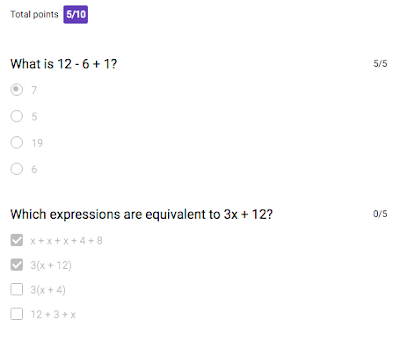The last time I looked at
Desmos (about five years ago), it was a cool online graphing calculator, but nothing compared to what I was using in a college classroom (where we had laptops running Maple). However, I looked at it last week with the eyes of a middle school teacher and fell in love with the activities and the activity builder.
The activities are an interesting mix of Nearpod (in that they provide sequenced activities for students) and Formative (in that student answers, including pictures, are displayed to the class). A lot of the activities are aimed higher than 6th grade, which makes sense when you are using a graphing calculator as your interface. My sixth graders do some graphing, but really don't get into the specifics of lines and certainly not anything more complicated. But I was able to find some already built activities that I will think will serve my sixth graders well.
My favorites so far are
Tile Pile (which mixes tetris type tiling with ratio tables),
Reflections (which does a good job of helping student draw and correct reflections across the x- and y- axis),
Exploring Triangle Area with Geoboards and
Exploring Quadrilateral Area with Geoboards (which do pretty much what they say), and
The (Awesome) Coordinate Plane Activity (picture below).
One thing I really like about the Desmos activity is that you can see all student submissions at once (using the overlay mode). So, for example, in the image above, you would see dots appear representing all the student answers. Hopefully, you see clustering, and if not, you know to do some reteaching. I find this much better to access than Formative where I could only bring up one student at a time (and that after searching for the correct submission).
I've done a little bit of authoring (which is best approached by editing other activities) to create one activity on
integers and opposites and another on
placing rational numbers on a number line. They are both pretty basic, but I wanted to get a good sense of how the activity builder worked.
 |
| I like how you can have graphs with moveable points and text boxes on the same page. |
If this works well with my students, I can see a few more activities I want to build. In particular, I know my students can struggle with distance in the coordinate plane, and this looks like a good tool to help them out.
Students access an activity using a code they input at student.desmos.com, and they can log in with a Google account if you wish. There's a nice dashboard to see student progress, but unlike Formative, there's no grading scheme that I could find. You will need to provide all the feedback in class. I also found site navigation a bit tricky --- you build your activities at teacher.desmos.com and learn about the tools at learn.desmos.com, but nothing at either site takes you to the other. I've had one hiccup in what I've tried to do, reported it to Desmos, and got confirmation that it was a known bug within a few hours, so that's decent support.
All in all, I feel like Desmos works better than Formative when it comes to graphing, but I still need to put it to the test in my class.











































